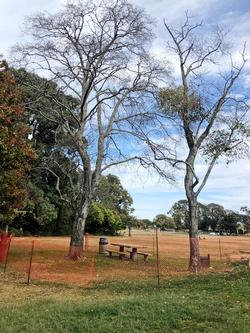Drought-stressed plants
-
Martha Proctor
-
California, particularly Northern California, is in its second year of a historically severe drought, the worst in nearly half a century. In Inverness, where I live, we have had less than half of our usual annual rainfall. Drought stress is painfully visible in the trees and plants in our gardens.
 Two trees dying due to drought Corte Madera Town Park October 2021. Photo: Martha Proctor
Two trees dying due to drought Corte Madera Town Park October 2021. Photo: Martha ProctorSymptoms of trees in drought conditions include wilting, curling, leaf scorch, discolored foliage, premature leaf drop, slowed growth, altered metabolism, die-back, and death if the drought continues indefinitely. Stressed trees often have stunted roots and may produce more seeds than in non-stressed periods. Buds will be tiny and affect next year’s growth. Not surprisingly, trees stressed by drought are also more susceptible to insect borers and canker, and other diseases.
Drought stress promotes disease by altering the plant’s physiology. Prolonged drought results in tissues drying out and compromised chemical reactions, ultimately reducing the plant's ability to produce defensive chemicals against pests and disease. This limited ability to protect themselves invites opportunistic diseases/fungi, e.g., Armillaria, Verticillium wilt, etc., and insects infect vulnerable trees/plants.
The amount of water a plant/tree needs depends a lot on the size and species of the tree and its location. Most of the fine roots that absorb water are in the top 12” of soil. Transpiration is the process through which water moves up from the roots through the trunk and branches and is released as water vapor from the stomata on the leaves. A mature oak tree with 200,000 leaves may transpire more than 110 gallons of water in a single day. If the ground is very dry, the plant struggles to keep up with the demand for water. In an extended drought, stomata close, leaves are dropped, and roots become less absorbent, shrivel up and die.
Several plant species employ specialized strategies such as closing their stomata to help them survive during a drought. Succulents, cacti, and orchids reduce evapotranspiration during the day by not opening their stomata. At night they open the stomata, which enables them to complete the process of photosynthesis during the day. Ferns and mosses can essentially cease metabolic activity. Other plants adapt by having thick leathery leaves (Ceanothus) or small leaves, which reduce surface area and thus water loss (Santolina), sunken stomata (pine needles) or shade their stomata to reduce contact with hot air (Lamb’s Ears). Removal of a drought-stressed tree in Corte Madera Town Park October 2021. Photo: Martha Proctor
Removal of a drought-stressed tree in Corte Madera Town Park October 2021. Photo: Martha ProctorPlants that are well established and adapted to their site are less affected unless the drought is unusually severe. It takes newly planted trees up to three years to develop a root system able to withstand moderate drought stress. Young plants depend on surface water for survival. Generally, if trees are unable to take up at least one inch of water per week during the summer, they will begin showing symptoms of drought stress.
Although the amount of water a tree or plant needs varies with the length of drought stress, soil drainage, soil type and texture, leaf and root type, competing vegetation, exposure to the sun, and other factors, there are some things you can do to support your plants and trees during a drought:
- Limit pruning as it increases stress on an already stressed plant
- Control weeds and grasses in the root zone to reduce competition for water
- Add mulch and organic matter to individual plants or beds to hold more moisture, help promote root growth & control weeds
- Monitor for early signs of pest damage or disease in summer heat and institute control measures promptly
- Remove dead/dying trees as quickly as possible to prevent them from becoming breeding grounds for bark beetles and other borers
- Place the highest priority for supplemental water on plants in the first three years following installation
- Avoid planting highly drought susceptible and shallow-rooted species in drought-prone sites, e.g., south-facing slopes, traffic islands, containers, compacted, gravelly or sandy soil
- Limit choosing plants intolerant of drought, including azaleas, Japanese maple, rhododendron, and hydrangeas.


